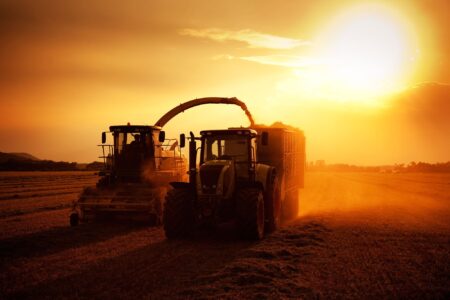Does this sound familiar? “I used to like to read the paper every morning. But now it is so full of politics and negative news that I only read the business and sports pages.”
That’s what a longtime customer from Iowa told me. He said he can still trade weather markets, but the markets driven by U.S. and global politics, changing trade policies, and tariffs are really tough. “I just can’t stomach all the angry news,” he said. “So I miss out on some of the facts.”
I understand how frustrating reading the morning paper can be these days. However, I still read three newspapers every morning. I put on my “mental filter” and scan the news for facts, trying to see through the anger and drama. It’s important for all of us, because in today’s grain market, politics and the decisions made in Washington and Beijing have a huge impact on the grain, energy, and livestock markets. I also like to report on overseas news events in my a.m. update.
While it’s important to understand how current events may move prices, when making selling decisions, I have learned to focus on reviewing my charts and making sure I am executing my plan. You can do that, too. Focus on what you can control. Do not let yourself fret about what you are reading in the newspapers or on the internet.
Here is a list of three key factors to review when evaluating where you are:
- Check your inventory. How many bushels do you have in the bin, and in the field? If you look at the current cash price, how much revenue is the crop worth? Write it down on a calendar or in a journal. Right now, you are not alone if the dollars you can generate by selling your crop do not create a profit. I know you can do this on a spreadsheet, but I think it really sinks in if you write it out by hand. (There is some psychological “click” that happens when you write it out by hand.) This is also a good exercise to do during the growing season, when yields and prices change week by week. You may not like the numbers sometimes, but the most important message is this: They change, over and over.
- Look at the big picture. Review your long-term weekly charts. Where are you today? Are you in the top, middle, or bottom third of the yearly price range? When you look at the long-term charts, you will also see how selling crops between August and October has usually been a marketing mistake.
- Consider storage. What is your current local bid? What are the grain bids out 60–90 days? Review what the grain market is paying you to store your crops until March–July. The combination of large carrying charges in the futures market and likely basis improvement adds up to a lot more money. You may be surprised at how much additional revenue is available to you by storing it for 60 to 90 days.
When you have accomplished these three steps, you are ready to build a marketing plan. Let’s do that together. Let’s make a first draft of a plan assuming you can hold your corn and soybeans at least until June–July. The price targets are all based on the July CBOT futures market. (If you need to sell between March and May, you need to lower the offers because the March and May futures are trading at a discount to the July contract.) This year, if you can work with your lender and manage to hold on to some or all your inventory until June or July, I think it will greatly pay off.
We start with targets. (I’m going to use my charts and a standard tool called retracements. More on this in the sidebar, above.) For July 2026 corn futures, here are my initial price targets: $4.66, $4.78, $4.88, and $5.27. As of late September, July 2026 corn futures have had a $1.01 per bushel trading range, from the $5.29 high in November 2023 to the $4.28 low in August 2025.
For July 2026 soybean futures, my initial price targets are at $11.04, $11.35, $11.69, and $12.75. As of late September, July 2026 soybean futures have had a $2.79 per bushel trading range, from the $12.77 high in December 2022 to the $9.98 low in December 2024.
For the July corn and July soybean price targets, I am using the standard retracements that many in the grain trade use, plus setting the last offer within 2–5¢ of the contract highs. The highest targets are not realistic at this time; reaching those will take some major crop production problems in South America or the U.S. next year. But be ready: If those targets are hit, then the news will be really, really bullish — and I guarantee, you will be reluctant to pull the trigger. (That is why you should have a plan before that happens, and promise yourself you will stick to it.)
Once we have our price targets, we set some time limits. You can’t wait forever to hit your targets; you have to pull the trigger sometime. That is the balance in the plan.
Key Selling Weeks
My initial plan is to make incremental sales during several key weeks. (This time plan may change after some of the key USDA reports in 2026.) Here are the important weeks: Nov. 28, 2025; Jan. 31, 2026; April 24, 2026; and May 22, 2026. These are important weeks, with an increased chance of a change of trend. I will sell during those weeks unless prices have been moving lower as the weeks approach. That is the one “no” signal for those weeks: I will not sell on weakness. Otherwise, I make a sale, regardless of my price targets.
And remember that drama in the news? You can take advantage of it. It is always good to have a plan, and to have offers in above the market. If the markets react, or overreact, to some dramatic news, then you can make a sale in the middle of the night, while you sleep.
Meanwhile, I will watch the news for facts. If the USDA makes major changes in the final crop production report, or if weather problems start to develop in South America, I will likely change some of the price targets when I update my plan. Note that those price targets are not price forecasts. This is my initial plan I put together after reviewing my long-term charts. These are some suggestions of where I think you should have offers in to make some incremental grain sales. This is why I like to use charts: to set price targets. This method takes the emotion out of the decision-making process.
It’s OK for you to watch the news again. Focus on the facts and events that can affect the price of your grain, and let the rest go on by.
Note: The risk of loss in trading futures and/or options is substantial, and each investor and/or trader must consider whether this is a suitable investment. Past performance — whether actual or indicated by simulated historical tests of strategies — is not indicative of future results. Trading advice reflects good-faith judgment at a specific time and is subject to change without notice. There is no guarantee that the advice given will result in profitable trades.


:max_bytes(150000):strip_icc()/WhiteHouse-2000-251df9c5b90d4c7da5a9226a5c8f9dac.jpg)

:max_bytes(150000):strip_icc()/Markets-5-Soybeans-dramatic-down-15-1dd1e8e5bab14a3b8e66f834c3b43908.jpeg)


:max_bytes(150000):strip_icc()/52491278470_c206e4f121_o-3aca74f8cb014fdea72b9e4ba1003435.jpeg)


:max_bytes(150000):strip_icc()/100908649_beef_cattle-d8fe6c19e13c42eaafdf1efb5cfe46fe.jpg)
:max_bytes(150000):strip_icc()/soybeans_usb-2-2000-f3cbf2d5ad334bbca68c6fb09087a9cd.jpg)